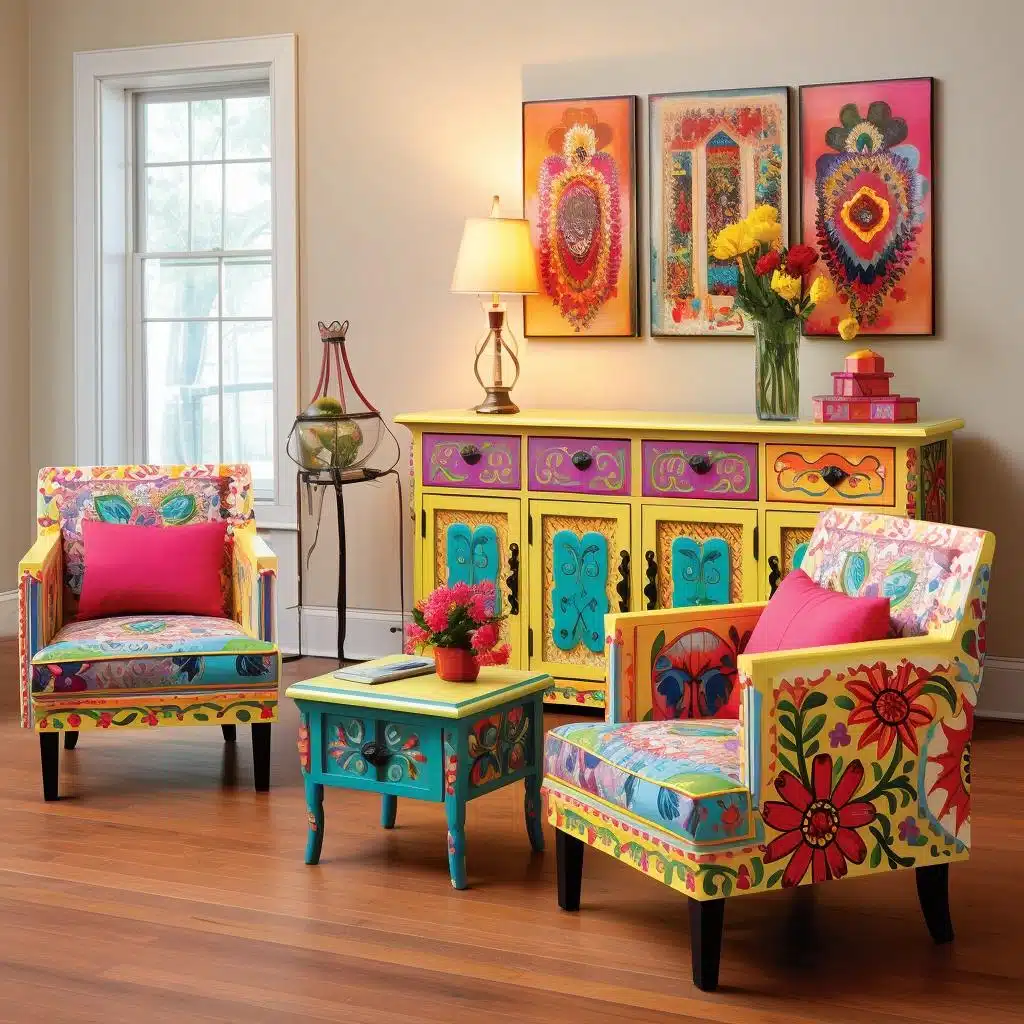Introduction
Ever looked at a piece of furniture and thought it could use a splash of color or a new lease on life? Painted furniture offers a charming and creative way to transform any space in your home. It’s an art form that combines practicality with aesthetics, allowing you to breathe new life into old pieces and make them uniquely yours.
History of Painted Furniture
Early Examples and Origins
Painted furniture dates back to ancient times, with early examples found in Egyptian tombs. These pieces were often adorned with intricate designs and vivid colors, showcasing the craftsmanship and artistic skills of the time.
Evolution Through the Centuries
As time progressed, painted furniture evolved, reflecting various art movements and cultural influences. The Renaissance brought elaborate designs, while the 18th century saw the rise of more refined and delicate pieces. Today, painted furniture continues to evolve, blending traditional techniques with modern trends.
Benefits of Painted Furniture
Customization and Personalization
One of the biggest perks of painted furniture is the ability to customize and personalize each piece. Whether you want to match your décor or create a statement piece, the options are endless.
Cost-Effective Home Makeover
Updating your furniture with paint is a budget-friendly alternative to buying new pieces. It’s a great way to give your home a fresh look without breaking the bank.
Eco-Friendly Options
Painting old furniture is also an eco-friendly choice. It reduces waste by recycling and repurposing existing pieces, contributing to a more sustainable lifestyle.
Popular Styles and Techniques
Distressed and Shabby Chic
The distressed and shabby chic styles are perfect for creating a vintage, time-worn look. These techniques involve sanding and layering paint to achieve a charmingly aged appearance.
Modern and Sleek
For a more contemporary feel, modern and sleek painted furniture uses clean lines and bold colors. This style is all about simplicity and sophistication.
Rustic and Farmhouse
Rustic and farmhouse styles embrace natural textures and earthy tones. These pieces often feature distressed finishes and muted colors, adding warmth and character to any space.
Choosing the Right Furniture for Painting
Types of Furniture Best Suited for Painting
Not all furniture is created equal when it comes to painting. Wooden pieces, whether solid or veneer, are typically the best candidates. However, you can also paint metal, laminate, and even plastic with the right preparation.
Materials and Surfaces to Consider
Understanding the material of your furniture is crucial for a successful paint job. Different surfaces require different preparation and paint types, so knowing what you’re working with will ensure the best results.
Preparation Before Painting
Cleaning and Sanding
Proper preparation is key to a smooth finish. Start by thoroughly cleaning the piece to remove any dirt, grease, or old finishes. Sanding is also essential to create a surface that paint can adhere to.
Priming Essentials
Priming helps to seal the surface and provides a base for the paint to adhere to. It’s especially important for dark woods or when using light-colored paint.
Repairing and Patching
Before painting, check for any damage that needs repairing. Fill in cracks, holes, or imperfections with wood filler, and sand smooth for an even surface.
Choosing the Right Paint
Types of Paint: Latex, Chalk, and Milk
Different projects require different types of paint. Latex paint is durable and easy to clean, chalk paint offers a matte finish and is great for a vintage look, and milk paint provides a unique, rustic finish.
Color Selection Tips
Choosing the right color can be daunting. Consider the existing color scheme of your room, the piece’s function, and your personal style when making your selection.
Finishes and Their Effects
The finish you choose can dramatically affect the final look. Glossy finishes offer a sleek, modern look, while matte finishes provide a more subdued, rustic feel.
Step-by-Step Guide to Painting Furniture
Gathering Supplies
Before you start, make sure you have all the necessary supplies: paint, brushes, sandpaper, primer, drop cloths, and protective gear.
Step-by-Step Painting Process
- Prepare the area by covering surfaces and laying down a drop cloth.
- Clean and sand the furniture.
- Apply a primer if necessary.
- Paint in thin, even coats, allowing each coat to dry before applying the next.
- Sand lightly between coats for a smooth finish.
Drying and Curing Times
Patience is crucial when painting furniture. Allow adequate drying time between coats and let the final coat cure for at least 24 hours before using the piece.
Creative Techniques and Tips
Stenciling and Designs
Stenciling is a fun way to add patterns and designs to your furniture. Use stencils to create intricate details or bold statements.
Ombre and Color Blending
Ombre and color blending techniques create a gradient effect, adding depth and interest to your piece. Start with the darkest color at the bottom and gradually blend to a lighter shade at the top.
Adding Metallic Accents
Metallic paints and accents can add a touch of glamour and sophistication. Use them sparingly to highlight details and create a striking effect.
Sealing and Protecting Painted Furniture
Topcoat Options
Sealing your painted furniture protects it from wear and tear. Polyurethane, wax, and varnish are popular choices for topcoats.
Application Techniques
Apply the topcoat in thin, even layers, allowing each layer to dry completely. This ensures a durable and long-lasting finish.
Long-Term Care and Maintenance
Maintaining your painted furniture involves regular cleaning and occasional touch-ups. Avoid harsh chemicals and use gentle cleaners to keep your piece looking its best.
Common Mistakes to Avoid
Skipping Preparation
Proper preparation is essential for a smooth and durable finish. Skipping steps like sanding and priming can lead to peeling and chipping paint.
Using the Wrong Type of Paint
Choosing the wrong type of paint for your project can result in poor adhesion and durability. Make sure to select a paint that’s appropriate for the material and intended use.
Ignoring Drying Times
Rushing the drying process can ruin your hard work. Allow each coat to dry thoroughly before applying the next.
DIY Painted Furniture Projects
Easy Beginner Projects
Start with small, simple pieces like picture frames or stools. These projects are great for practicing your technique and gaining confidence.
Advanced Techniques for Pros
Once you’ve mastered the basics, challenge yourself with more complex projects like dressers or dining tables. Experiment with different styles and techniques to create unique, custom pieces.
Inspiration from Around the Web
Popular Trends on Pinterest and Instagram
Social media platforms are treasure troves of inspiration. Browse Pinterest and Instagram for ideas and trends that spark your creativity.
Influential Furniture Painters to Follow
Follow influential furniture painters for tips, tutorials, and inspiration. These experts share their knowledge and showcase their beautiful creations.
Conclusion
Painted furniture offers a wonderful way to personalize your home, breathe new life into old pieces, and explore your creative side. Whether you’re a beginner or a seasoned pro, there’s always something new to learn and try. So grab your brushes and paint, and start transforming your furniture today!
FAQs
Can I paint over varnished furniture?
Yes, you can paint over varnished furniture, but it requires proper preparation. Sand the surface to remove the glossy finish and apply a primer before painting.
What is the best paint for high-traffic furniture?
For high-traffic furniture, use a durable paint like latex or enamel. These paints withstand wear and tear and are easy to clean.
How do I fix mistakes on painted furniture?
If you make a mistake, don’t worry! Lightly sand the area to smooth it out and reapply the paint. For larger mistakes, you may need to repaint the entire section.
Can I use spray paint for furniture?
Yes, spray paint can be used for furniture, especially for intricate or detailed pieces. It provides a smooth, even finish and is available in various colors and finishes.
How do I clean painted furniture?
To clean painted furniture, use a soft cloth and mild soap. Avoid harsh chemicals or abrasive cleaners that can damage the finish.







